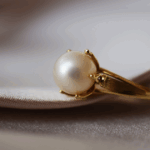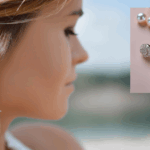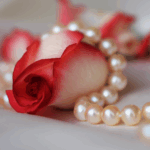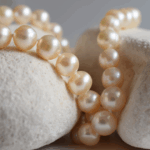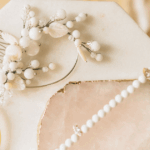Unlocking Elegance: A Guide to Pearl Necklace Clasps
Introduction
The perfect pearl necklace is a timeless treasure, a symbol of grace passed down through generations.
Pearl necklace clasp types vary widely, from the simple and functional spring ring and lobster claw to the highly decorative filigree and box clasps. Modern options like magnetic and toggle clasps offer ease of use, while vintage styles like fishhook clasps provide a unique aesthetic. The best choice depends on the necklace’s weight, style, and the wearer’s need for security versus convenience.
The Unsung Heroes: Why Your Clasp Matters More Than You Think
Let’s be honest. When you first gaze upon a string of luminous pearls, your eyes are drawn to their soft glow, their perfect roundness, their ethereal beauty. The last thing you probably notice is the tiny piece of metal at the back. And yet, that humble clasp is the unsung hero of your entire piece of jewelry. It’s the gatekeeper, the guardian, the silent partner that ensures your precious pearls stay securely around your neck, where they belong. Choosing the right fastener isn’t just a practical decision; it’s an integral part of the necklace’s overall design, security, and even its story.
A clasp does more than just connect two ends of a string. It influences how you wear the necklace. Can you put it on by yourself in a hurry, or does it require a patient partner or a few minutes in front of a mirror? It affects the necklace’s drape and longevity. A clasp that’s too heavy can cause undue stress on the silk thread, while one that’s too flimsy can be a constant source of anxiety. It also contributes to the aesthetic. A beautifully ornate vintage clasp can be a focal point, intentionally worn to the side, while a sleek, modern clasp can disappear seamlessly, letting the pearls take center stage. Think of it as the final punctuation mark on a beautiful sentence. It can be a simple period, a confident exclamation point, or an ornate flourish that adds a whole new layer of meaning. In this guide, we’ll journey through the fascinating world of these small but mighty mechanisms.
The Foundation of Your Choice: Security, Style, and Self-Reliance
Before we dive into the nitty-gritty of specific clasp types, it’s crucial to understand the three core pillars that should guide your decision: security, style, and self-reliance. First, security is paramount. Your pearl necklace is an investment, both financially and emotionally. The clasp’s primary job is to prevent loss. The level of security you need often corresponds to the value and weight of the pearls. A heavy, double-strand of South Sea pearls demands a far more robust closure than a delicate, lightweight freshwater pearl choker. We’ll explore mechanisms like safety catches and locking systems that offer peace of mind.
Second, consider the style. The clasp should complement the necklace, not compete with it. A modern, minimalist strand of Akoya pearls would look out of place with a frilly, antique filigree clasp. Conversely, a simple lobster clasp might feel like a missed opportunity on a dramatic, vintage-inspired piece. The metal type—yellow gold, white gold, platinum, or sterling silver—also plays a vital role in creating a cohesive look. And finally, think about self-reliance and ease of use. Are you someone who values the ability to fasten your jewelry quickly and without assistance? Or do you have dexterity challenges, such as arthritis, that make small, intricate clasps a frustrating ordeal? Your daily life and physical needs are just as important as the pearls themselves. By balancing these three factors, you can select a clasp that is not just a closure, but a perfect partner for your pearls.

The Classics: Time-Tested Fasteners You’ll See Everywhere
Some designs are classics for a reason. They are reliable, familiar, and get the job done with minimal fuss. In the world of jewelry, a few clasp types have risen to become the go-to standards for jewelers and wearers alike. These are the clasps you’ve likely encountered countless times, even if you never knew their proper names. They are the workhorses of the industry, balancing functionality with a subtle elegance that allows them to blend in with a wide variety of necklace styles.
Their popularity stems from a proven track record of dependability and cost-effectiveness. Manufacturers can produce them in vast quantities, making them an accessible option for everything from fashion jewelry to fine pearl strands. For the wearer, their familiarity is a comfort. You intuitively know how to operate a lobster claw or a spring ring. This section will delve into these ubiquitous and trustworthy options, exploring the nuances that make each one suitable for different purposes and why they remain the bedrock of necklace design.
The Humble Spring Ring Clasp: A Delicate Staple
If you’ve ever owned a delicate chain necklace, you’ve almost certainly met the spring ring clasp. It’s a perfectly circular ring with a tiny, spring-loaded lever that you pull back to create an opening. You then slip the small ring from the other end of the necklace into this opening and release the lever, which springs back into place to secure the closure. It’s a marvel of simple engineering and is prized for its low profile. Because it’s a complete circle, it blends in beautifully with the chain or the findings of a pearl necklace, offering a clean, unobtrusive look. This makes it a fantastic choice for lighter, more delicate pearl necklaces, such as single-strand Akoya or freshwater pearls, where a bulky clasp would overwhelm the design.
However, the spring ring’s delicacy is both its greatest strength and its most significant weakness. The very things that make it discreet—its small size and tiny lever—can also make it maddeningly difficult to operate, especially for those with long nails, larger fingers, or dexterity issues like arthritis. Trying to pull back that minuscule nub while guiding the other end into the gap can feel like performing microsurgery. Furthermore, the internal spring can wear out over time, losing its “springiness” and becoming less secure. It’s generally not recommended for heavy or exceptionally valuable necklaces, as a forceful tug could potentially pull it open. Despite these drawbacks, for a lightweight, everyday pearl strand where subtlety is key, the spring ring remains a classic and cost-effective choice.
The Mighty Lobster Claw Clasp: Security Meets Simplicity
The lobster claw clasp is the spring ring’s more robust and popular cousin. Shaped, as the name suggests, like the claw of a lobster, it features a spring-loaded lever on one side that opens the “pincer.” This larger lever provides significantly more surface area for your finger or thumb to press, making it dramatically easier to open and close than a spring ring. The mechanism is also inherently more secure. The enclosed design and stronger spring mean it’s far less likely to be pulled open accidentally. This combination of enhanced security and user-friendliness has made the lobster claw the most common clasp on the market today for a huge range of jewelry.
You’ll find lobster clasps on everything from sterling silver chains to high-end gold and platinum pearl necklaces. They come in various sizes, from dainty versions for delicate pieces to heavy-duty models for substantial men’s chains or weighty pearl strands. The elongated, stylized shape provides a bit more visual presence than a spring ring, but it’s still considered a functional rather than a decorative clasp. It offers a fantastic middle ground: more secure and easier to use than a spring ring, but less bulky and ornate than a box or toggle clasp. If you’re looking for a reliable, all-around performer for a medium-weight pearl necklace that you plan to wear frequently, the lobster claw is almost always an excellent and worry-free choice. Its reputation for strength gives wearers the confidence they need to enjoy their pearls without constant anxiety.
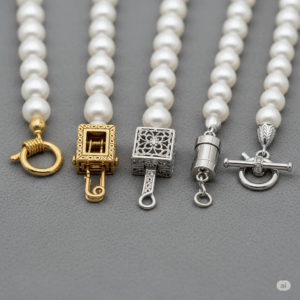
Elegance Embodied: Clasps That Are Jewels Themselves
Moving beyond pure function, we enter the realm of clasps that are designed not to be hidden, but to be seen. These are the closures that double as decorative elements, adding an extra layer of artistry and value to the necklace. They transform a simple fastener into a focal point, a piece of miniature sculpture that is as beautiful as the pearls it secures. These clasps are often chosen for higher-end, formal, or vintage-style necklaces where every component is expected to contribute to the overall luxurious aesthetic.
Wearing a necklace with one of these clasps offers a different kind of experience. You might find yourself intentionally sweeping your hair up or choosing an asymmetrical neckline to show it off. It can be worn at the back in the traditional style, or swung to the side or even the front to be displayed as a pendant. This category of clasps speaks to a time when craftsmanship was paramount, and even the most functional parts of a piece of jewelry were an opportunity for beauty. Let’s explore some of the most stunning examples of these wearable works of art.
The Elegant Box Clasp: A Picture of Perfection
The box clasp is the quintessential choice for classic, high-quality pearl strands. It consists of two parts: a box-like housing and a tongue or wedge-shaped piece of metal that clicks securely into it. The mechanism is highly secure, as it requires a specific action—pushing down on an external lever—to release the tongue. This makes accidental opening extremely unlikely. What truly sets the box clasp apart, however, is the “box” itself. Its flat, broad surface is a perfect canvas for decoration. Jewelers can set it with small diamonds, sapphires, or other gemstones. It can be engraved with intricate patterns, milgrain edges, or even feature a larger, central pearl.
This decorative potential is why box clasps are synonymous with luxury. They integrate seamlessly into the design of a fine pearl necklace, elevating it from a simple strand to a truly finished piece of jewelry. Many box clasps also feature an additional safety measure: a small figure-eight or “sister” clasp that snaps over the side for redundant security. This gives the wearer ultimate peace of mind. The only real downside to a box clasp is that it can be a bit tricky to operate one-handed. It often requires two hands to line up the tongue and push the release lever. However, for a formal, valuable necklace that you won’t be taking on and off frequently, the unparalleled security and aesthetic beauty of a box clasp make it the gold standard.
The Intricate Filigree Clasp: Vintage Charm Personified
A filigree clasp is, in essence, a type of box clasp that has been taken to the next level of artistry. The term “filigree” refers to a delicate kind of metalwork created by twisting and curling fine threads of precious metal (like gold or silver) and soldering them together to create an intricate, lace-like pattern. When applied to a clasp, this technique results in a stunningly beautiful and airy design that evokes a sense of antique romance and old-world craftsmanship. Filigree clasps are light, yet strong, and their ornate appearance makes them a perfect match for vintage or heirloom pearl necklaces. They don’t just secure the necklace; they add a story to it.
The intricate patterns can be floral, geometric, or swirling abstract designs, and they often incorporate milgrain detailing (tiny beads of metal along the edges) for added texture and sparkle. Like a standard box clasp, the mechanism is typically a secure tongue-and-groove system, sometimes with an added safety catch. They are a statement in themselves and are often designed to be worn visibly. A beautiful filigree clasp on a strand of pearls whispers tales of a bygone era of elegance and attention to detail. While their delicate appearance might suggest fragility, a well-made filigree clasp is surprisingly durable. They are the perfect choice when you want the clasp to be a key part of the necklace’s romantic narrative, adding a touch of vintage charm that is simply timeless.
The Innovators: Modern Solutions for Today’s Wearer
As lifestyles have evolved, so too have the demands we place on our jewelry. The modern wearer often values speed, convenience, and accessibility just as much as traditional aesthetics. This has led to the development of innovative clasp designs that cater specifically to these needs. These are the clasps for the person on the go, for the individual with dexterity challenges, or for those who simply prefer a clean, contemporary look.
These modern solutions often prioritize clever engineering and minimalist design over ornate decoration. They solve common problems—like the frustration of fumbling with a tiny clasp behind your neck—with elegant simplicity. While they may not have the long history of a box clasp, they have quickly earned their place in the jewelry world by offering a level of convenience that was previously unimaginable. This section celebrates the ingenuity of modern clasp design, showcasing options that make wearing beautiful pearl necklaces easier and more accessible for everyone.
The Magical Magnetic Clasp: Effortless and Chic
For anyone who has ever struggled to fasten a necklace, the magnetic clasp feels like pure magic. It consists of two ends, each containing a powerful little magnet (usually a rare-earth magnet like neodymium). To close the necklace, you simply bring the two ends near each other, and they snap together with a satisfying click. To open it, you slide them apart or pull them directly apart (depending on the design). There are no tiny levers to pull or small holes to aim for. The ease of use is simply unparalleled, making them a life-changing option for people with arthritis, limited mobility, or anyone who just hates fiddling with traditional clasps.
Of course, with great convenience comes a need for caution. The primary concern with magnetic clasps is security. A strong tug on the necklace could potentially pull the magnets apart. For this reason, they are not recommended for very heavy or extremely valuable pearl strands. However, many modern magnetic clasps are surprisingly strong and often incorporate design features like interlocking grooves or a ball-and-socket shape to prevent them from being pulled apart easily. They are an excellent choice for lightweight to medium-weight necklaces intended for everyday wear. Their appearance is typically sleek and modern, often spherical or cylindrical, which complements contemporary pearl jewelry styles beautifully. They represent a perfect marriage of high-tech convenience and minimalist style.
The Stylish Toggle Clasp: Form and Function in Harmony
The toggle clasp is a beautiful example of a design that is both a secure fastening mechanism and a prominent decorative element. It consists of two distinct pieces: a ring (the “toggle”) and a bar. To secure the necklace, you simply slip the bar horizontally through the ring and then let it fall into place. The tension of the necklace chain or strand holds the bar securely against the ring. It’s an intuitive and incredibly easy clasp to operate one-handed, as it relies on simple, large-scale manipulation rather than fine motor skills.
The beauty of the toggle clasp lies in its bold, geometric presence. It’s meant to be seen. Jewelers often craft toggle clasps with interesting textures, hammered finishes, or unique shapes for the ring and bar. Because of its decorative nature, it’s very common to see necklaces designed to be worn with the toggle clasp at the front or side as the main feature. It works wonderfully with modern, bohemian, or chunkier pearl styles, like baroque pearl necklaces, where it adds to the artistic, slightly rustic vibe. In terms of security, it’s surprisingly effective for most necklaces. The only risk is if the necklace becomes so slack that the bar can rotate and slip back through the ring, but for a properly fitted necklace under normal tension, it’s quite reliable. The toggle clasp is the perfect choice when you want a closure that is both effortlessly easy and makes a confident style statement.
A Journey Through Time: Vintage and Antique Clasp Styles
Jewelry is a time capsule. Every element, from the cut of a gemstone to the style of a clasp, can tell us something about the era in which it was made. Delving into the world of vintage and antique clasps is like an archaeological dig into the history of fashion and technology. These are the fasteners that adorned the necks of women in the Victorian, Edwardian, and Art Deco periods. They reflect the materials, tools, and aesthetic sensibilities of their time.
Often crafted by hand with meticulous care, these clasps possess a character and charm that is difficult to replicate with modern mass-production techniques. They might feature hand-engraved details, long-forgotten gemstone cuts, or clever mechanisms born of necessity before the invention of modern springs. Understanding these styles is not only fascinating for history buffs but also essential for anyone collecting, inheriting, or looking to purchase antique pearl jewelry. Let’s uncover the secrets of some of these beautiful relics from the past.
The Deceptive Fishhook Clasp: An Old-World Secret
One of the most elegant and traditional fasteners, particularly for single or multi-strand pearl necklaces, is the fishhook clasp. This design consists of a decorative, often oval-shaped box on one end and a sleek, stylized metal hook on the other. To secure it, you simply insert the hook into the opening of the box. The tension of the necklace holds it in place. What makes this clasp so beloved for fine pearls is its appearance; when closed, it looks like a continuous, decorative bead, seamlessly integrated into the strand. It doesn’t interrupt the flow of the pearls, especially in multi-strand designs where the clasp can be a wide, ornate centerpiece.
The security of a traditional fishhook clasp relies purely on tension, which can be a concern for some. However, many finer versions, especially from the mid-20th century onwards, evolved to include a clever locking mechanism. The hook is designed with a spring-loaded tongue inside the box, so it “clicks” into place and cannot be removed without pressing a release. This modernizes the security while retaining the classic, seamless look. Finding a true vintage pearl necklace with a beautifully crafted fishhook clasp, perhaps adorned with seed pearls or small diamonds, is a real treat. It speaks to a commitment to cohesive and uninterrupted design that is a hallmark of high-quality, classic pearl jewelry. For more information on historical jewelry, a resource like the Gemological Institute of America (GIA) provides deep insights.
The S-Hook Clasp: Ancient Simplicity Reimagined
The S-hook clasp is one of the oldest and most elemental forms of fastening, with its origins tracing back to ancient civilizations. As the name implies, it’s a simple piece of metal bent into an “S” shape. One end of the necklace attaches to one loop of the S, and the other end is hooked onto the other loop. Its beauty lies in its elegant simplicity. In its most basic form, it’s not the most secure option, as a snag could potentially unhook it. However, jewelers have adapted this ancient design for modern use in several clever ways.
Often, one loop of the S-hook is permanently soldered closed around its attachment ring, so only one side is used for fastening. For added security, the open end of the hook might be pinched slightly more closed or feature a slight decorative curl that makes it harder for the ring to slip off accidentally. The S-hook is rarely used for very fine or heavy pearl necklaces but is a popular choice for artisanal, bohemian, or rustic designs. It lends a handcrafted feel to a piece. You might find it on necklaces featuring irregularly shaped baroque pearls or mixed-media designs that incorporate leather or silk cords. It’s a nod to the past, a simple and effective mechanism that has endured for centuries because of its graceful form and straightforward function.
Specialty Clasps for Unique Pearl Strands
Not all pearl necklaces are a simple, single strand. Jewelry designers are constantly pushing the boundaries, creating dramatic layered looks, opera-length ropes that can be worn in multiple ways, and bracelets that require their own unique fastening solutions. These specialized designs call for specialized clasps that can handle the unique challenges they present, whether it’s managing multiple strands, providing versatile connection points, or hiding the closure altogether.
These specialty clasps are the problem-solvers of the jewelry world. They are engineered to provide stability for complex designs, ensure that layered necklaces lie flat and untangled, and offer the wearer creative ways to style their pieces. They demonstrate a deep understanding of how a necklace interacts with the body and the importance of creating hardware that supports the designer’s artistic vision. Let’s explore some of these ingenious solutions for non-traditional pearl arrangements.
Mastering the Multi-Strand: Keeping Your Layers Perfect
A multi-strand pearl necklace, whether a two-strand choker or a dramatic three-strand bib, makes a bold and luxurious statement. However, keeping those strands perfectly aligned and untangled requires a special kind of clasp. Enter the multi-strand clasp. These are essentially wider box clasps or slide-lock clasps that have multiple loops or rings on each side, one for each strand of the necklace. This ensures that the pearls remain parallel to each other, creating a beautiful, uniform cascade effect on the neck. Without such a clasp, the individual strands would inevitably twist around each other, creating a messy and uncomfortable tangle.
These clasps come in a variety of styles. The most common is a rectangular box clasp, whose width provides an excellent canvas for elaborate decoration with gemstones or intricate engraving, turning the clasp into a stunning focal point. Another popular style is the slide-lock or tube clasp, where two tubes slide into one another and lock in place. These offer a more modern and streamlined look. When choosing a multi-strand pearl necklace, the quality of the clasp is critically important. It must be strong enough to support the combined weight of all the strands and engineered precisely to maintain their perfect spacing. It’s a crucial component that ensures a complex design looks elegant and polished, rather than chaotic.
The Invisible Touch: The Magic of Hidden Clasps
For the ultimate in seamless, uninterrupted beauty, nothing beats a hidden clasp. This is a highly specialized type of fastener designed to be completely indistinguishable from the pearls themselves. It is most often found in very high-end necklaces where the designer wants to create the illusion of a perfect, endless circle of pearls. The mechanism is genius in its subtlety. One of the pearls in the strand is actually the clasp. This “pearl” is hollowed out and engineered to screw, click, or lock onto a metal post hidden within the pearl next to it. When closed, it is virtually impossible to spot the closure without knowing exactly where to look.
This type of clasp, also known as a pearl clasp or ball clasp when it mimics a decorative metal bead, is a testament to extraordinary craftsmanship. It requires precision engineering to ensure the mechanism is both secure and invisible. It is the perfect choice for an “opera” or “rope” length pearl necklace, as these long strands are often worn looped multiple times or knotted in the front, and a visible traditional clasp would interrupt the flow and limit styling possibilities. While they can be a bit trickier to operate since you have to find the specific “clasp pearl” first, the aesthetic payoff is immense. It creates a pure, flawless line, allowing the pearls—and only the pearls—to shine.
Choosing the Right Clasp: A Practical Decision-Making Guide
By now, it’s clear that the world of pearl necklace clasps is far richer and more varied than one might initially suspect. With so many options, how do you make the right choice? The perfect clasp for your beloved aunt’s vintage pearls might be completely wrong for the modern, minimalist strand you wear to the office. The decision-making process is a personal one, a careful balancing act between the practical and the aesthetic.
This section is designed to be your hands-on guide. We will break down the selection process into four key, actionable factors. By considering each of these elements in relation to your specific necklace and lifestyle, you can move from being overwhelmed by choice to feeling empowered and confident in your selection. This is where you become the expert on your own jewelry, ensuring the clasp you choose enhances not only the beauty of your pearls but also your enjoyment of wearing them.
Factor 1: Security vs. Convenience
This is the most fundamental trade-off in clasp selection. Generally speaking, the most secure clasps (like a box clasp with a safety catch) are the most intricate to operate. The most convenient clasps (like a magnetic clasp) are inherently the least secure against a strong pull. You need to honestly assess your priorities. Are you choosing a clasp for a priceless family heirloom that you wear only on special occasions? If so, security is your number one priority. Opt for a box clasp or a high-quality lobster clasp. A few extra seconds of fumbling are a small price to pay for peace of mind.
On the other hand, is this for an everyday, lightweight pearl necklace that you want to throw on as you’re running out the door? Or do you have physical limitations that make traditional clasps a daily source of frustration? In these cases, convenience reigns supreme. A strong magnetic clasp or an easy-to-use toggle clasp will dramatically improve your quality of life and ensure you actually wear and enjoy your pearls instead of leaving them in the jewelry box. There is no right or wrong answer here, only the answer that is right for you.
Factor 2: Aesthetics and Necklace Style
The clasp is the finishing touch, and it must be in harmony with the rest of the piece. Look at the overall style of your pearl necklace. Is it vintage and romantic? A filigree clasp would be a stunning addition. Is it modern, sleek, and minimalist? A polished magnetic clasp or a simple barrel clasp would complement it perfectly. Is it a bold, artistic piece with large, irregular baroque pearls? A textured toggle clasp or a stylized S-hook would enhance its bohemian vibe.
Also, consider the metal. The clasp metal should match the other findings on the necklace and complement the overtone of the pearls. The warm glow of yellow gold is a classic pairing that enhances the creaminess of many pearls. The cool, bright finish of white gold, platinum, or sterling silver provides a crisp, contemporary contrast, especially beautiful with white or black pearls. Don’t treat the clasp as an afterthought; view it as a key design element that completes the necklace’s aesthetic story. For a deeper understanding of metal properties, Wikipedia’s page on precious metals is an excellent resource.
Factor 3: The Weight and Value of Your Pearls
This is a non-negotiable, practical consideration. The clasp must be physically capable of supporting the weight of the necklace without straining or breaking. A delicate little spring ring simply cannot handle the heft of a double-strand 10mm Tahitian pearl necklace. The sheer weight would put constant stress on the spring mechanism and the jump ring connecting it, creating a major failure risk. For heavy necklaces, you must choose a clasp that is engineered for strength: a large lobster claw, a barrel clasp, or, ideally, a box clasp. These designs distribute the weight more effectively and have more robust locking mechanisms.
Value goes hand-in-hand with weight. The more valuable the necklace, the more you should invest in a high-security clasp. It makes no sense to protect a $10,000 necklace with a $5 clasp. For high-value pearls, a box clasp with a secondary safety catch (like a figure-eight lock) is the professional standard. It provides two layers of protection against accidental loss. Always err on the side of caution. Over-engineering the security of your clasp is a wise investment that protects the much larger investment of the pearls themselves.
Factor 4: Dexterity and Ease of Use
This is a deeply personal factor that is too often overlooked. Think about the physical act of putting on and taking off your necklace. Do you have long fingernails that make gripping tiny levers difficult? Do you have arthritis, tremors, or neuropathy in your hands that makes fine motor control a challenge? Are you simply a busy person who doesn’t have the patience to struggle with a clasp in front of the mirror each morning? Be honest with yourself about your physical needs and preferences.
If dexterity is a concern, clasps that require pinching or precise alignment, like spring rings and some smaller box clasps, should be avoided. Instead, look for solutions that are designed for ease. Magnetic clasps are the number one choice for effortless fastening. Toggle clasps are a close second, as they involve large, easy-to-manipulate pieces. Larger lobster claws are also much easier to handle than small ones. Choosing a clasp that you can operate comfortably and confidently will mean the difference between a piece of jewelry that brings you joy and one that causes frustration.
The DIY Corner: How to Replace a Pearl Necklace Clasp
Sometimes, a perfectly beautiful pearl necklace is let down by a broken, worn-out, or simply unsuitable clasp. Perhaps the spring has failed on an old spring ring, or you’ve decided you need the convenience of a magnetic clasp on a strand you inherited. The good news is that in many cases, you can replace the clasp yourself with just a few simple tools and a bit of patience. This can be a rewarding project that breathes new life into a beloved piece of jewelry.
However, a word of caution: this guide is intended for necklaces where the clasp is attached via a metal ring or finding at the end of the strand. If your pearls are knotted all the way to the clasp, with the clasp being an integral part of the knotting, this is a job for a professional jeweler or a pearl stringer. Attempting to do this yourself could result in a broken strand and scattered pearls. For standard attachments, however, it’s a very manageable task.
Gathering Your Tools and Supplies
Before you begin, you’ll need to assemble a small toolkit. Having the right tools makes the job infinitely easier and prevents you from damaging your jewelry. You will need:
- Two Pairs of Pliers: The best choice is two pairs of chain-nose or flat-nose pliers. These have smooth jaws that won’t mar the metal. Avoid pliers with serrated teeth, as they will leave marks. The two pairs are needed to twist open jump rings correctly.
- Your New Clasp: The replacement clasp of your choice. Ensure it’s an appropriate size and metal for your necklace.
- Jump Rings (Optional): The small ring that connects the clasp to the necklace is called a jump ring. It’s often a good idea to have a few new ones on hand, as old ones can be weak or misshapen. Make sure they are the same metal as your clasp.
- A Soft Work Surface: A bead mat, a piece of felt, or a soft cloth. This prevents your pearls from rolling away and protects your work surface.
- Good Lighting and Magnification (Optional): A task lamp and a magnifying glass can be a huge help, as these components are very small.
Step-by-Step Replacement Guide
With your tools and supplies ready, find a quiet, well-lit space to work.
- Examine the Connection: Look closely at how the current clasp is attached. It’s almost certainly connected to a small metal ring at the end of the pearl strand (often called a “French wire” or “gimp” cover) via a jump ring. You will be opening this jump ring.
- Open the Jump Ring: This is the most crucial step. Never pull a jump ring open. This will distort its circular shape and weaken the metal. Instead, grip the jump ring with your two pairs of pliers, with the split or opening at the top (12 o’clock position). Hold one side steady with one pair of pliers and use the other pair to twist the other side away from you, like opening a gate. This keeps the ring’s shape intact.
- Remove the Old Clasp: Once the jump ring is twisted open, you can simply slide the old clasp off. Slide the end loop of the pearl strand off as well, if you are also replacing the jump ring.
- Attach the New Clasp: Slide the new jump ring (or the old one, if it’s in good condition) onto the end loop of the pearl strand. Then, slide the loop of your new clasp onto the same jump ring.
- Close the Jump Ring: Using your two pliers again, simply reverse the opening motion. Twist the open end back towards the closed end until they meet perfectly. Run your finger over the join; it should be completely smooth, with no gap for the chain to slip through.
- Repeat on the Other Side: Most clasps come in two parts. Repeat the process on the other end of the necklace to attach the second part of your new clasp (e.g., the small ring that a lobster clasp clips onto).
Discover Your Perfect Clasp at Vintage Pearl Necklace
Feeling inspired to find a pearl necklace with the perfect combination of beauty, security, and style? Or perhaps you’re ready to upgrade an existing piece with a high-quality, elegant clasp that truly does it justice.
At Vintage Pearl Necklace, we believe that every detail matters. We offer a curated collection of stunning pearl jewelry, paying close attention to the quality and design of every component, especially the clasps. Explore our selection and find the piece that speaks to you.
Visit us today at https://vintagepearlnecklace.com/ to unlock your own piece of timeless elegance!
Conclusion
The journey through the world of pearl necklace clasps reveals a surprising depth of ingenuity, artistry, and practicality. What begins as a simple mechanism to join two ends of a string unfolds into a critical element that defines a necklace’s security, comfort, and character. From the steadfast reliability of the lobster claw to the effortless magic of a magnetic closure, and from the ornate beauty of a filigree box clasp to the seamless perfection of a hidden one, the choices are as varied as the pearls themselves.
Ultimately, the perfect clasp is a personal choice. It’s an informed decision that balances the financial and sentimental value of your pearls with your lifestyle, your aesthetic preferences, and your physical needs. By understanding the distinct advantages and unique personalities of each clasp type, you are empowered to choose a fastener that doesn’t just close your necklace, but completes it. It’s the final, crucial detail that provides peace of mind and transforms a beautiful string of pearls into a cherished and wearable piece of art.
Frequently Asked Questions (FAQs)
1. What is the most secure type of clasp for a valuable pearl necklace? The most secure clasp is widely considered to be a box clasp, especially one that includes a secondary safety catch (like a figure-eight lock). The mechanism requires a deliberate action to open and the safety catch provides a redundant layer of protection, making accidental loss highly unlikely.
2. I have arthritis. What is the easiest pearl necklace clasp to use? For those with arthritis or dexterity challenges, the magnetic clasp is by far the easiest to use. It requires no pinching or fine motor skills, fastening with a simple magnetic click. A toggle clasp is also an excellent, easy-to-use option as it involves manipulating larger pieces.
3. Can I change the clasp on my pearl necklace? Yes, in most cases, you can. If the clasp is attached with a simple jump ring, a jeweler can swap it out easily, or you can even do it yourself with the right tools. If the pearls are knotted directly into the clasp, you will need a professional pearl stringer to do the job, as it requires re-knotting the end of the strand.
4. How do I clean my pearl necklace clasp? Clean the metal clasp carefully using a soft polishing cloth. For a deeper clean, you can use a soft toothbrush with a tiny amount of mild soap and water, but be extremely careful not to get the silk thread of the pearl strand wet, as this can weaken and stretch it. Always dry the clasp thoroughly.
5. What clasp should I choose for a very heavy, multi-strand pearl necklace? For a heavy, multi-strand necklace, you need a clasp designed for both weight and alignment. A multi-strand box clasp or a slide-lock clasp is the best choice. These are built to support the combined weight and have multiple attachment points to keep the strands from tangling.
6. Are toggle clasps safe for pearl necklaces? Toggle clasps are surprisingly secure for most light to medium-weight necklaces. The tension of the strand holds the bar in place against the ring. However, they are not recommended for very heavy or very loose-fitting “slacky” necklaces, as there is a small chance the bar could rotate and slip out if tension is lost.



